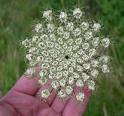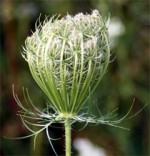 A native of Europe and southwest Asia, this tough biennial has naturalized in Canada and US where it grows in disturbed sites and has become invasive in many areas and is considered a noxious weed. Queen Anne’s lace is a member of the carrot family (Apiaceae) and related to celery, dill, angelica, cilantro, and parsley as well as to poison hemlock. It is also the plant from which all cultivated carrots were cultivated. The leaves are roughly triangular in shape, tripinnate, and finely divided. The small cream-colored flowers are carried in dense flat umbels up to three inches across from May to October. Some flowerheads have a single red to purple flower in the center which is believed to attract insects. As the flower heads mature they curl up to form a bird’s nest like structure. Care should be taken when handling the plant because the leaves can cause skin irritation in susceptible individuals.
A native of Europe and southwest Asia, this tough biennial has naturalized in Canada and US where it grows in disturbed sites and has become invasive in many areas and is considered a noxious weed. Queen Anne’s lace is a member of the carrot family (Apiaceae) and related to celery, dill, angelica, cilantro, and parsley as well as to poison hemlock. It is also the plant from which all cultivated carrots were cultivated. The leaves are roughly triangular in shape, tripinnate, and finely divided. The small cream-colored flowers are carried in dense flat umbels up to three inches across from May to October. Some flowerheads have a single red to purple flower in the center which is believed to attract insects. As the flower heads mature they curl up to form a bird’s nest like structure. Care should be taken when handling the plant because the leaves can cause skin irritation in susceptible individuals.
 Type: Biennial
Type: Biennial
Size: 24-48” H x 12” W.
Light: Full sun to part shade
Soil: Average to lean, moderately moist, well-drained
Hardiness: Zones 3-9
Beneficial Insects Attracted: Lacewing, ladybug, hoverfly, parasitic mini wasps, minute pirate bug, eastern black swallowtail, bees